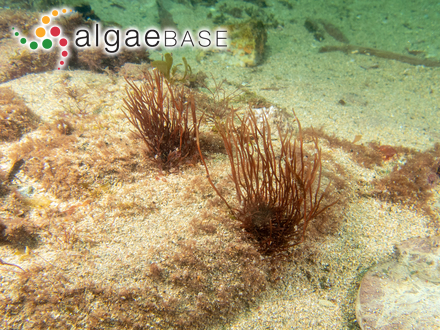Cordylecladia erecta (Greville) J.Agardh 1852

Current name:
Cordylecladia erecta (Greville) J.Agardh
Thurleston, South Devon, England - 15 October 2021. Francis Bunker (marineseen@me.com)
Publication Details
Cordylecladia erecta (Greville) J.Agardh 1852: 704
Published in: Agardh, J.G. (1852). Species genera et ordines algarum, seu descriptiones succinctae specierum, generum et ordinum, quibus algarum regnum constituitur. Volumen secundum: algas florideas complectens. Part 3, fasc. 1. pp. 701-786. Lundae [Lund]: C.W.K. Gleerup.
Type Species
This is the type species (lectotype) of the genus Cordylecladia.
Status of Name
This name is of an entity that is currently accepted taxonomically.
Basionym
Sphaerococcus erectus Greville
Type Information
Syntype localities: "In the sea; February. Discovered in England by Mrs Griffiths at Tor-Abbey rocks, Meadfoot, Waldon rocks, &c. in Torbay; and at Sidmouth."; (Greville 1828: pl. 357) Lectotype: Mrs Griffiths; February; E; (Jones 1962: 143) Notes: Paratypes: BM-K, LD. Lectotype from Sidmouth (Jones 1962: 143).
Origin of Species Name
Adjective (Latin), erect (Stearn 1983).
General Environment
This is a marine species.
Description
Narrow cylindrical, cartilaginous, brownish-red fronds, to 100 mm high, in tufts from thin, spreading, discoid base often hidden below sand. Sparingly subdichotomously branched, branches usually tapering to fine point. Dioecious. Tetrasporangia and spermatangia in terminal, deciduous, spindle-shaped pods, cystocarps clustered in swollen areas near apices. Reproduction takes place in the depths of winter.
Habitat
On sand-covered rocks, low intertidal and subtidal, widely distributed, frequently overlooked.
Similar Species
Frequently confused with Gracilaria longissima and Gracilaria gracilis both of which do not have an expanded crustose base. Cordylecladia erecta is smaller, generally stands erect and has a brownish-red rather than a purplish-red colour. Plants of Gracilaria longissima may have irregularly sollen areas when growing in sand or shell-sand. Reproductive plants of C. erecta are only found in winter when the reproductive structures occur in swollen, often spindle-shaped areas near the tips of the fronds.
Created: 30 March 1996 by M.D. Guiry.
Last updated: 10 January 2025
Verification of Data
Users are responsible for verifying the accuracy of information before use, as noted on the website Content page.
Distributional notes
Mediterranean record from Spain (Gallardo et al., 1985) needs verification. - (11 May 2006) - G.M. Guiry
"... all Mediterranean herbarium specimens examined (labelled as C. erecta), resulted as misidentifications with species belonging to different genera. The only published records of this species from the Mediterranean Sea are those from Caesarea, Mikhmoret and Bat Yam (Israel) reported by Einav & Israel (2008). However, because of such records are not documented, we think that the occurrence of this species in the Mediterranean Sea should be confirmed." (Cormaci, Furnari & Alongi 2021: 264). Blalencic - (26 August 2021) - M.D. Guiry
Linking to this page: https://www.algaebase.org/search/species/detail/?species_id=12
Citing AlgaeBase
Cite this record as:
M.D. Guiry in Guiry, M.D. & Guiry, G.M. 10 January 2025. AlgaeBase. World-wide electronic publication, National University of Ireland, Galway. https://www.algaebase.org; searched on 01 April 2025
 Request PDF
Request PDF














